ROOSEVELT'S REVENGE
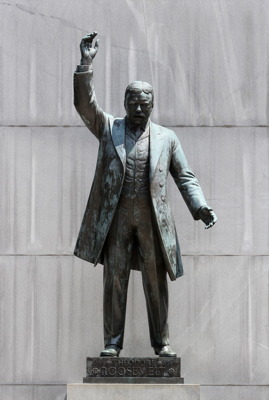 Of the five presidential monuments in our nation's capital (Washington, Lincoln, Jefferson, FDR, and TR). Theodore Roosevelt's is by far the largest in size. It is also the least visited.
Of the five presidential monuments in our nation's capital (Washington, Lincoln, Jefferson, FDR, and TR). Theodore Roosevelt's is by far the largest in size. It is also the least visited.
The main reason for its relatively low visitation is that it is not on the Mall like the other presidential monuments and is a bit out of the way, being an island in the Potomac River. Access to the island is a bit complicated as the island cannot be accessed from the South bound lane of the George Washington Memorial Parkway unless one is driving an Abrams tank and can crash though the Jersey barriers and access the parking lot. True, one can overshoot the Roosevelt Island by a couple of miles on the South bound parkway, then make a U turn to the parking lot.
It is unlikely that parking will be a problem. As noted, it is the least visited of the Presidential Memorials. After parking, you can then take the hundred yard foot bridge to Roosevelt Island. That is the normal way of visiting the Theodore Roosevelt Memorial, but it is not the best way.
The best way to visit Theodore Roosevelt is by canoe or kayak.
Fortunately, this is no inconvenience for me as I always carry a tandem kayak on top of my vehicle for reasons of self-defense and safety.
Say again?
Well, you see, I live in the Washington DC Area, the third most traffic congested Metropolitan area in the U.S. (Los Angeles and San Francisco come in first and second; New York and Boston come forth and fifth.)
When you travel constantly in such traffic you need an edge. A large red kayak on top of your vehicle, with red flag flying gayly from the stern, gives you that edge.
People instinctively give you lots of room. ("Edna, he might harpoon us with that thing.")
Works like a charm. Even buses and 18 wheelers can be intimidated.
Sometimes, days, even weeks go by without my actually using my kayak, but it is on board if I need it.
"Let's see Theodore Roosevelt Island while we can," I suggested to my wife, Joan.
(A greedhead California Congressman, Richard Pombo, now blessedly defeated, had suggested that Roosevelt Island be sold to developers to help pay off the national debt. Theodore would revolve in his grave. Joan was amenable, so we packed a lunch and started out on Highway 495 and picked up the George Washing Memorial Parkway on the Virginia side to the Potomac. Like most NPS parkways, the George Washington Memorial Park way is a delightful deception: The four lane road way is thickly lined with Eastern decidious trees to a depth of a hundred feet or less. This provides the illusion that you are traveling through the original forest of John Smith and Chief Powhatan.
Everyone knows that it is an illusion, but it is a nice one. Far superior to the grim reality of a Los Angeles freeway. There are exits along the parkway marked with the discreet NPS white on brown signs, indicating such sites as Fort Marcy, a Civil War earthwork where Vince Foster shot himself.
There is also the same White and brown signage inviting you to drop in to the George Bush Center for Intelligence. Many tourists from Iowa or California are intrigued by this sign, believing it to be an oxymoron and stop to take a picture or, out of curiosity, take the exit.
This would be a mistake. The George Bush Center for Intelligence is the headquarters of the CIA and you will be met with an armed response and no, they don't have a museum or visitor center or particularly want visitation.
We breezed past Roosevelt Island and continued on for about two miles and the Columbia Island Marina, a part of GWMP, but leased to a concessionaire.
We launched our Kayak, "Koala Bear" at the Marina boat ramp, which is free to kayaks and canoes, but charges $5 for power boats. If the wind is blowing hard and you don't like the chop on the main Potomac channel, you can hang a right in the marina and go up a narrow, tree lined channel which is protected from the wind almost to Theodore Roosevelt Island.
However, the Potomac is a tidal river and this is not recommended except at high tide.
Besides, the best views are from the main channel of the river itself. So we took a left, and then another left, past the houseboats out into the Potomac, framed by the graceful arch of a GWMP bridge. These GWMP bridge arches are some of the scenic treasures of the Parkway, as they allow the photographer to frame the classic shots of the DC monuments with the stone and concrete of the bridge arches.
The Potomac was smooth, the breeze gentle, and the tide flowing.
You can make good time in a tandem kayak if you are at all coordinated, and we had done this many times before. We soon entered the channel between the island and the Virginia side of the Potomac, looking for a place to land on the island. That is not as easy as you might think.
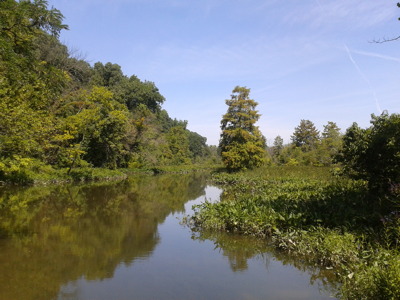 The core of the island is very hard Mica Schist, but the shoreline is mud flats This is very active mud as tidal mud flats tend to be; sucky, yucky, and knee deep in places. It is also contaminated mud with the residue of partially treated sewerage lingering a bit longer in the mud than the river itself.
The core of the island is very hard Mica Schist, but the shoreline is mud flats This is very active mud as tidal mud flats tend to be; sucky, yucky, and knee deep in places. It is also contaminated mud with the residue of partially treated sewerage lingering a bit longer in the mud than the river itself.
While the Potomac is a lot cleaner than it was even ten years ago, you really don't want to go wading in Potomac River mud.
Now your National Park Service is agnostic on the subject of visiting Roosevelt Island by kayak or canoe, neither encouraging nor discouraging the practice.
For its part, the NPS has provided you with a perfectly decent 100 yard foot bridge, and that, as far as the NPS is concerned, is that.
However, if you persist in being difficult, the NPS will allow that there are some areas that make for an easier landing than others. I was told that the best landing spot was on the DC side of the island. The trick was to line up your craft with the huge initials "GW" (George Washington University Rowing Team) that is painted on a concrete wall on the DC side of the Potomac.
Once lined up with the initials, you look across the river to Roosevelt Island. You should be able to spot a ten foot pole which is said to mark the best mud free landing spot on Roosevelt Island.
(By now you may be feeling frustrated and mutinous. Maybe the NPS was right! Maybe the simplest thing to do would be to take the footbridge over to Roosevelt Island and be done with it!)
Nonsense! What would Theodore think! You must lead the strenuous life! You must take the most difficult trail and the most chances You must aspire to be... Theodore! (He hated to be called "Teddy".)
The pole marks the spot where there is a good gravel bottom and it is easy to drag a kayak or canoe ashore. This we did. There is a short trail that connects with the main trail system that circles the island.
The Island, around 88 acres, is quite diverse, with two main ecosystems; a swamp and an upland forest, 30 feet above sea level at the highest point.
The swamp trail is more than a half mile of boardwalk; the "boards" being recycled plastic, which holds up better than God's stuff in a humid environment.
The NPS has wisely skipped heavy duty nature evangelizing; very few interpretive signs, letting the urban wilderness speak for itself.
George Washington would recognize most of the tree species (though none of the individual trees date back to George Washington's time.) The island, known variously as My Lord's, Barbados, and Mason's Island, was a working farm, off and on, for 300 years. Some exotics have established a foothold on the Island. In the case of English Ivy, it is a serious enough threat that the NPS is using herbicide to control this pest,
There are quite a few spots in the Washington, DC area where, if you look in the right direction, things look pretty much as they did when John Smith and Pocahontas were sizing each other up.
However, there are no places in the DC area that sound like that time or even the time of Theodore Roosevelt. And Roosevelt Island is no exception. The island is in the flight path of Ronald Reagan Washington National Airport.(Symbolism there, neighbors!) and one can hear the surf-like rumble of traffic on the George Washington Memorial Parkway.
Still, the visuals are great and it is a pleasure to walk through a recovering forest.
Eventually, sooner or later, no matter which of the circular trails you take you will arrive at the monument to Theodore Roosevelt.
Unlike all the other memorials to former Presidents, this one is in a clearing in the forest and you sort of happen upon it like a ruined Mayan temple in the jungle. The effect is impressive.
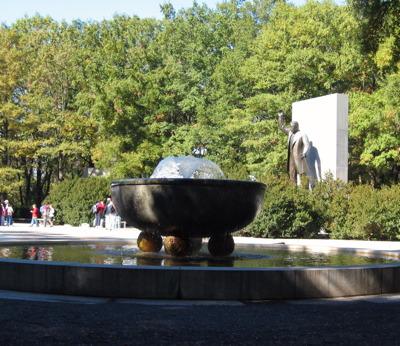 There are huge stone bowls, which are fountains when they are functioning (which they were not), a river that goes nowhere (now dry) I am not sure what this is supposed to symbolize; perhaps the futility of a politician's promises. There is also a heroic ten foot tall bronze statue of
Theodore, arm raised in full cry. (He loved to give speeches.) Flanking the statue, are four
25 foot tall Stonehenge-like slabs of rock inscribed with Roosevelt's opinions on the subject.
There are huge stone bowls, which are fountains when they are functioning (which they were not), a river that goes nowhere (now dry) I am not sure what this is supposed to symbolize; perhaps the futility of a politician's promises. There is also a heroic ten foot tall bronze statue of
Theodore, arm raised in full cry. (He loved to give speeches.) Flanking the statue, are four
25 foot tall Stonehenge-like slabs of rock inscribed with Roosevelt's opinions on the subject.
They are MANHOOD, THE STATE, YOUTH, and NATURE. Each word got its own rock.
Joan was aghast. "Did he really say this stuff?" she asked incredulously.
"Well, I guess so," I answered uncertainly, "They woudn't be there if he didn't say them."
I could see her point. Most of the quotes sounded like what a not too bright high school football coach might say at a Rotary breakfast in a very conservative midwestern town.
One quote from the NATURE slab sounded like it had been written by Donald Trump himself: "Conservation means development as much as it does Protection."
A quote from the MANHOOD tablet has the fanatical ring of an Osama Bin Laden sermon exhorting the faithful: "Only those are fit to live who do not fear to die and none are fit to die who have shrunk from the joy of life and the duty of life."
Another quote from the NATURE rock tells us "There is hardy life in the open." Well, yes, but would you carve it on a rock?
The STATE slab provides us with "Order without Liberty and liberty without order are equally destructive" which sounds like a slick argument for the "guided democracy" of our 45th President.
Back to MANHOOD, we were instructed that "A man's usefulness depends on his living up to his ideals, as far as he can." Theodore's qualifier "as far a he can" provides an escape hatch for the idealism challenged of say, the Trump Administration, who reached their idealism limit rather quickly.
Joan looked at me rather oddly, as she knew Theodore was one of my heroes.
"I'll have to research this!" I said, stout as any Bull Moose, as we walked back to our kayak.
As it turned out, Roosevelt deserved better. He did say these things, but the quotations had been cherry picked by folks who may have had an agenda. Although the Monument was designed by the architect, Eric Gugler and dedicated in 1967, the quotes were lifted almost verbatim from the Roosevelt Memorial Rotunda at the American Museum of Natural History in New York City. (At that time, early 1930's, the museum was under the influence of some rather conservative folk such as Harry Fairfield Osborne, a noted Ivy League racist.)
Theodore was a complex individual and had a conservative side as well as a somewhat radical side. It is possible that the folks that put together the quotes for the Roosevelt Memorial Rotunda preferred to emphasize his conservative side.
(It should be pointed out that none of this is the fault of the NPS which did not select the quotes but only protects the island and its monument.)
Perhaps the Theodore Roosevelt Memorial Association which purchased the island for the American people in 1932 as a memorial to the 26th President might give some consideration to providing more uplifting quotations.
For example, the Trump-like quote "Conservation means development as much as it does protection" is only Trump-like because it has been taken out of context. The next sentence in the original quote reads "I recognize the right and duty of this generation to develop and use the natural resources of our land, but I do not recognize the right to waste them or to rob by wasteful use, the generations that come after us."
Theodore Roosevelt had other pithy quotes that the Memorial Association might consider caving in stone:
- "I hate a man that skins the land."
- "To befoul the unholy alliance between corrupt business and corrupt politics is the first task of the statesmanship of the day."
- "The country will not be a permanently good place for any of us to live unless we make it a reasonably good place for all of us to live."
- A man who had never gone to school may steal from a freight car, but if he has a university education, he may steal the whole railroad."
- "Patriotism means to stand by the country, it does not mean stand by the President or any other public official."
- "That we are to stand by the President right or wrong, is not only unpatriotic and servile, but it is morally treasonable to the American public."
- "Here is your country. Cherish these natural wonders. Cherish the natural resources, Cherish the history and romance as a sacred heritage for you children and your children's children. Do not let selfish men or greedy interests, rob your country of its beauty, its riches or its romance."
EDWARD ABBEY
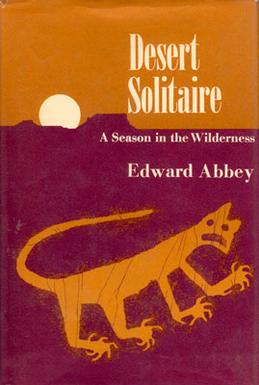 "He was a very difficult man to live with" said his fifth and final wife, Clarke Abbey.
"He was a very difficult man to live with" said his fifth and final wife, Clarke Abbey.
I suspect that he was. Edward Abbey was a man you'll not meet every day.
Indeed, though we had mutual friends, such as the artist John Du Puy, who suggested that we get together, your editor took great care to see that our paths did not cross. I had a feeling that Cactus Ed and The Christian Bureaucrat would not see eye to eye on a variety of matters.
In short, I admired Abbey in the abstract. I enjoyed Abbey's writing without being forced to enjoy Abbey. That is probably the best way to approach any writer including the Christian Bureaucrat.
Writers tend to be scoundrels; not all of them, of course, but enough to skew the statistical norm. Abbey was no exception,
However, before Abbey came along, nature writers were supposed to be the exception. They were supposed to be inspirational, or uplifting, or poetical, or (God help us.) saintly. Names like John Muir, or John Burroughs, or Rachel Carson come to mind. Abbey clearly broke that mold. There was nothing saintly about Edward Abbey.
Abbey's response to food, drink, and women was more akin to Henry VIII than John Muir.
Abbey worked as a seasonal ranger in both the National Parks and the National Forests, on and off for several decades.
It was not a match made in heaven.
Abbey did not understand the Zen of Bureaucracy and the bureaucracy did not understand the existentialism and anarchy of Edward Abbey.
Abbey, for his part, always had his priorities straight. If, for example, as campground ranger, Abbey's job was to clean the restrooms and restock the toilet paper, he was willing to do so.
HOWEVER, if a long-legged, willowy blonde lassie in the campground looked at all like she needed fulfillment, Abbey would have to reprioritize his work schedule. Sometimes, toilet paper never DID get restocked!
Now neighbors, as you know the twin pillars of the faith of the NPS bureaucracy are # 1 GET YOUR REPORTS IN ON TIME and # 2, MAINTAIN CLEAN AND WELL STOCKED REST ROOMS.
Do these two things and you will go far. Abbey consistently failed the Restroom Test. and the Showing Up On Time Test, and, occasionally, The Even Being Present Test.The mission-oriented bureaucrats (Often the wrong mission.) did not quite understand how to make use of a natural resource like Ed Abbey. The toilet paper restocking portion of his job description should have been dropped and Abbey assigned to write reports; something he was very, very good at; only he called them essays and books.
In the best off all bureaucratic worlds, Abbey would have been given the title and duties of GS-5 Cougar Habitat Inspector provided with a pickup truck, camping equipment, credit card limited to gas and groceries (no need to place undue temptation in Ed's path). His assignment would be to check out all present and future cougar habitats in North and South America and provide regular reports on his findings.
While his paycheck would depend on the reception of these reports, Abbey could write about anything he thought or felt about. He would not be in any regular contact with a supervisor. (Something that always seemed to be a problem.) Abbey could repackage his reports as books and sell them to anyone who would want to buy them, with the government taking a cut.
Would such an arrangement lead to malfeasance or misuse of government funds?
Probably, but not on the order of government contractors in Iraq and Afghanistan and the taxpayers would have something to show for at the end of the day.
Abbey hoped to be the Great American Novelist. He picked the wrong trail.
His novels were overblown and stereotypical; with cartoonish heroes and villains.
His real forte was the astringent, desert dry aphorisms with which he skewered the wicked developers and his collections of long essays, really travelogues, in which he lyrically painted word pictures of his beloved and endangered Southwest.
Many of his pithy remarks stick in the mind long after you have read them
"Grown men do not need leaders.""Men love their ideas more than their lives, and the more preposterous idea, the more eager they are to die for it. And kill for it."
"Our Neoconservatives are neither new nor conservative, but old as Babylon and evil as hell."
"The American West, including Alaska, is one of the few places left on Earth where it is still possible to make a stand against the zeal of the growth fanatics, the graph paper mentality of the GNP economists, the replenish and forever multiply theology of the American Yahoo Church.
All of the descendants of those avaricious peasants who swarmed across the Atlantic to fall like a plague of locusts upon the sweet, lovely, defenseless, virgin lands of America. If we can draw the line against the Industrial machine in the West and make it hold, then perhaps in the decades to come, we can force industry underground where it belongs and restore to our parts of our nation their rightful heritage of breathable air, drinkable water, democratic industrialism and decentralized agriculture. Finally, and most importantly, provide for every man, woman and child sufficient open space to make possible the fullest realization of human freedom. What good is a Bill of Rights that does not imply the right to play, to wander, to stillness, to solitude, to discovery and physical adventure."
(Ironically, Abbey's dream of wildness came true not in the American West, but in Scotland, the Home of the Industrial Revolution with the passage of The Right to Roam Act by the Scottish parliament.)
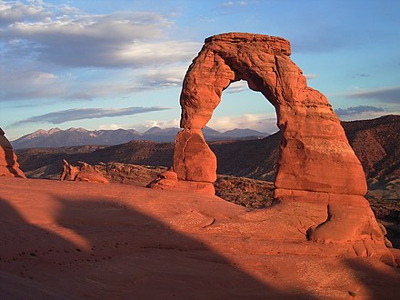 Of all his books, the one that Abbey favored least was Desert Solitaire, a collection of essays that he wrote at Arches National Monument. Much to Abbey's chagrin, "Desert Solitaire" became an environmental icon; the kind that requires academic genuflection, inclusion on Environmental course reading lists and presence in bibliographies and indexes.
Of all his books, the one that Abbey favored least was Desert Solitaire, a collection of essays that he wrote at Arches National Monument. Much to Abbey's chagrin, "Desert Solitaire" became an environmental icon; the kind that requires academic genuflection, inclusion on Environmental course reading lists and presence in bibliographies and indexes.
Abbey was almost embarrassed by the success of Desert Solitaire.
Abbey went on to write other collections of essay and novels.
Then he died.
Death is hard on a writer. (Yes, I know that folk wisdom has it that writers are immortal, that their works live on forever; but they really don't.) Most writing goes out of style or becomes dated and the poor writer, being dead, is no longer around to revise and update their ideas and their books are placed in the morgue of university libraries; literary corpses visited only by the graduate student in search of a suitably arcane thesis subject.
This does not seem to be the case with Edward Abbey. Though his body has long since moldered away in his famously secret grave somewhere in the Southwest, his literary and environmental activist reputation remain alive and kicking.
Abbey was a hard writer to pigeon hole. He definitely did not want to be pinned down as an environmental or nature writer or even as a liberal polemicist. His rather xenophobic writings and rantings on the evils of unrestricted immigration in general, and Mexican immigration in particular, won him nearly as many enemies on the Left as his attacks on "Welfare ranching and logging" produced on the Right. If Trump were capable of sustained reading and writing, Abbey would be his favorite environmentalist.
Like many writers, Abbey invented and reinvented his persona.
The comparison of Grey Owl (Archie Belaney) and Edward Abbey is particularly interesting.
Belaney, a middle class Englishman, posed as an American Indian in the Canadian Rockies and worked as a seasonal Parks Canada interpreter, wrote many articles on native lore and became known as "The Saint Francis of the beavers".
Although denounced as a fraud and a poseur, he meant well and has been rehabilitated by Parks Canada as one of Canada's most eloquent nature writers.
Abbey has also been denounced as a fraud and a poseur for quite skillfully constructing an image of himself as an eco-terrorist; a zorro-like anarchist and monkey wrencher, which was simply not the case with this rather shy, quiet and mild-mannered man.
So does Edward Abbey deserve some kind of memorial? The answer seems to be in the affirmative, if for no other reason than to answer the question of the casual visitor as to "Who was this man?"
It is true that there is a historical marker near his birth place of Home, Pennsyvania, but he really should be memorialized Out West some place.
Arches National Park, where he wrote Desert Solitaire is the obvious place.
Fortunately, the Visitor Center at Arches National Park has been refurbished, and the National Park Service with whom Abbey frequently sparred, has commemorated its most famous seasonal ranger with an interpretive panel within the VC.There is a photo of Ed Abbey taken around the time of his service at Arches. The caption says "Edward Abbey spent much of his adult life exploring the canyons of Southern Utah. Two summers as a park ranger inspired his best known book Desert Solitaire: A Season in the Wilderness.
The text of the two narrative paragraphs follows:
"Edward Abbey once said that there will always be things worth fighting for, and things worth fighting against. In his book, Desert Solitaire: A Season in the Wilderness, Abbey recounts his experiences as a seasonal ranger at Arches in the summers of 1956 and 1957 'while living in a little tin government house trailer near Balanced Rock.' The book has become standard reading for environmental activists and all who enjoy the solitude of the desert.Abbey interspersed eloquent descriptions of the natural history of the park with warnings about 'Industrial tourism' and personal objections to the planned development of Arches. Through Desert Solitaire, millions of people got a glimpse of Arches when it was still a little known monument at the end of a little used dirt road.
The road is paved now and Abbey's trailer is gone but his spirit lives on in the people who continue to search for the feeling of personal freedom evoked by this desert landscape."
Now neighbors! That's government writing at its rare best! Short and to the point!
Abbey would have liked that!
SAFETY MESSAGE
 Now neighbors, if you plan to go kayaking on the C & O Canal on a summer's weekend, you are going to have trouble finding a place to park unless you arrive waaay early. Should you be tardy, you will have to wait; however, wisdom comes to those who stand and wait and I was about to learn a valuable safety lesson.
Now neighbors, if you plan to go kayaking on the C & O Canal on a summer's weekend, you are going to have trouble finding a place to park unless you arrive waaay early. Should you be tardy, you will have to wait; however, wisdom comes to those who stand and wait and I was about to learn a valuable safety lesson.
Joan and I arrived late at the Violette Lock parking lot. It looked like I would have to park on the access road and portage our tandem kayak farther than preference would indicate.
But hark! Was someone leaving? An early bird kayaker who had fulfilled his aerobic and spiritual rejuvenation requirements?
Huzzah! Jesus truly loves us! A young lawyer-lobbyist looking chap had just placed his kayak atop his Ford Explorer and looked like he was putting his gear away. I moseyed our Toyota Tacoma over to a respectful but vigilant manner as one does in a crowded parking lot, very much the way a polite turkey vulture will sidle up to a dying Jack rabbit.
The kayaker finished putting away his helmet, paddles and life jacket in the back of the Explorer.
He then checked and tightened the tie-downs of his kayak very leisurely.
We waited expectantly.
He got in the Explorer. Nothing happened. No STRUM of 6-8 gas guzzling cylinders roaring into life. Nothing.
After a moment or two, Joan decided to inquire of the driver's plans for the immediate future.
I reminded her to be careful. She agreed that she would.
I had faith in her. My spouse is an extroverted, positive, logical, type A personality, willing to share her opinions with others. That can get you into a whole lot of trouble in today`s America.
Over the years, I have finally, finally convinced her that it is very unsafe to get into arguments with strangers in traffic or parking lots.
That is because a significant percentage of American drivers are, well, insane.
A driver`s license might require that you wear glasses while driving, but no license requires that you be sane while doing so. The ACLU and the United Maniacs of America would sue on the basis of cerebral discrimination.
Joan has finally accepted that a 9 mm Glock under the seat will trump an Ivy League Degree in any traffic debate.
Joan politely asked the driver about his immediate plans.
The driver was rude, but Washington, DC Subtle Rude, rather than In your face New York City Rude, which will strip the varnish off furniture.
He allowed as how he would eventually leave, but only when the spirit moved him and that we should enjoy the day until that happened.
Annoying, yes, but insufficient grounds to light into him with tire tools. We patiently waited.
After an interval had passed that indicated he was his own master of the Universe and no one could tell him what to do, he drove off.
 "Strange" observed Joan.
"Strange" observed Joan.
"What's strange?" I asked
"You didn't notice?" (I find that I am always playing Dr. Watson to her Sherlock Homes.)
"Notice what?"
"His bumper sticker" She observed, Holmesingly. "It was VISUALISE PEACE. He apparently has not quite internalized the concept."
"Perhaps Peace is hard to visualize in Washington, DC," I said philosophically.
"Perhaps," said Joan. "Let's go kayaking."
And so we did, and I thought no more of rudeness and bumper stickers.
Until the next morning, when the WASHINGTON POST brought up the idea of bumper stickers as a safety issue.
It seems, according to an article in the June 16 issue of the Washington POST, that if you want to avoid aggressive drivers, road rage, and the attendant court and hospital appearances, you should try to avoid drivers that have bumper stickers on their cars.
Now neighbors, that sounds like everyday common sense.
That is, it is prudent to avoid drivers that have bumper stickers that say:
YOU CAN TAKE MY GUN WHEN YOU PRY IT FROM MY COLD, DEAD FINGERS.
Or MY KID CAN WHIP YOUR HONOR STUDENT'S ASS.
Or GOD, GUNS AND GUTS IS WHAT MADE AMERICA GREAT.
However, according to a study by a State University of Colorado social psychiatrist, Professor Szlemko; it does not seem to matter whether the message on the bumper sticker is about peace and love, or patriotism, or war, or the Second Amendment, or Donald Trump or whatever.
You are just as likely to trigger a homicidal response from some citizen who has an ENVISION PEACE or WAR IS NOT THE ANSWER sticker should you cut him/her off in traffic as from drivers sporting traditional truculent statements such as THIS CAR INSURED BY SMITH & WESSON.
Does this mean that you could get blown away by someone with a JESUS LOVES YOU sticker?
Yup! At least according to the Colorado State study.
How does Professor Szlemko know this for a fact?
Well, like a good scientist, he ran an experiment, and a risky one at that.
A volunteer driver would drive into the left turn lane of a busy intersection. When the green arrow appeared, he did not move. He did not move until the car behind honked. An observer with a stopwatch noted (a) how long it took the honker driver to honk and (b) the presence or absence of bumper stickers and or personalized license plates and (c) the statement on the bumper sticker or the personalized license plate.
The team found that drivers with bumper stickers or personalized plates honked a good two seconds earlier than drivers with no bumper stickers or personalized plates.
According to Dr. Szlemko's study, the reason for the aggressive response from drivers with bumper stickers or personalized plates is territorial. Drivers who individualize their cars with bumper stickers or personalized plates see their cars in much the same way as they see their homes or bedrooms as deeply private spaces.
What the aggressive driver forgets is that while you are in your private space, your car, that car is traveling along a public space, the road.
"The more markers a car has, the more aggressively the person tends to drive when provoked.
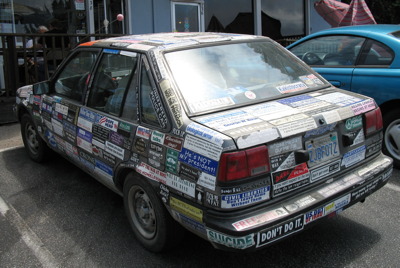 Just the presence of territorial markers predicts the tendency to be an aggressive driver.
Just the presence of territorial markers predicts the tendency to be an aggressive driver.
So, neighbors, does this mean that when you are out on patrol in the Natchez Trace Parkway and spot a car with a JESUS SAVES bumper sticker, being driven erratically, does this mean that you should unsnap the keeper on the holster of your Sig Sauer before making that stop?
Not necessarily.
There may be other reasons people have bumper stickers.
Joan has a bumper sticker on her Toyota Camry. I asked her if it indicated a vicious streak? (Admittedly, I could have used better phrasing, considering the response.)
Her bumper sticker says SCOTTISH COUNTRY DANCERS DO IT BETTER.
Does this mean that Joan will lop off your head with her trusty Claymore if you cross her in traffic?
Not at all. It is true that Joan is passionate about her hobby of Scottish Country dancing, but Joan has another reason for having a bumper sticker.
According to her, "Toyota makes a generally excellent car, but Toyota bumpers are crappy." The Scottish Country Dancing bumper sticker neatly covers a crack in the bumper.
Nothing more profound; no matter what Professor Szlemko says.
MARY BOMAR
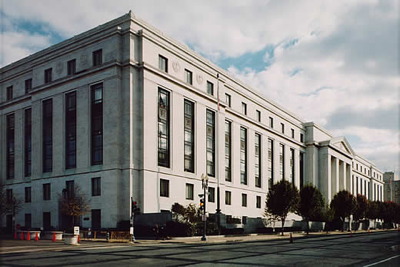 The environmentalist gadfly, Edward Abbey, once observed that "The National Parks are one of the few nice things that a remote and suspicious government actually does for its citizens."
The environmentalist gadfly, Edward Abbey, once observed that "The National Parks are one of the few nice things that a remote and suspicious government actually does for its citizens."
Actually, there are a few other things; not many, but a few. One of these is these is the little known fact that the government will entertain you free of charge.
You see, you are quite welcome to attend a Congressional Hearing on, say, whether the Army Corps of Engineers should dredge the Tombigbee River. There is no charge.
All you have to do is show up and exhibit a sober demeanor.
Now there are those who would claim that watching cement harden or paint dry has greater entertainment value than a Congressional Hearing. This is not true. All hearings tell a story and all have a certain drama for the insiders who understand the background.
That is why, when I heard there would be a Senate hearing on the candidacy of Mary Bomar for the directorship of the National Park Service, I resolved to attend.
I put on a sober-sided suit and tie. There is no formal dress code but you are supposed to do the right thing for the occasion, very much like not wearing bib overalls to Grampa's funeral.
You may bring your children, but the little gentlemen and ladies should be togged out in their Sunday best to impress upon them the non-mischievous nature of the occasion.
I then walked the mile from my home to the Wheaton Metro station and descended trustingly into a hole in the ground like a character in Alice in Wonderland and found myself at Union Station and the short walk to the Wonderland of the U.S. Capitol and its attendant office buildings.
The Bomar hearing would be held at the Dirksen Senate Office Building, a Mussolini marble confection named after Senator Everett McKinley Dirksen, Republican leader of the Senate for several geological epochs. Dirksen was most famous for his quip "You know, may not seem like much, a million here, a million there, but pretty soon you're talking about real money."
As befits a democracy, security at the Dirksen Building is competent but relaxed, helpful and non-obtrusive. This comes as a surprise if you are used to the security of the NPS digs at "Eye" Street. There, you don't get in unless someone knows you, and more importantly, wants to see you, don't go there to pick up a brochure or learn about your National Park Service.
The Congressional Office buildings, on the other hand, exude the bon homme of a rural country court house, with everybody being friendly and helpful. The Congressmen (and women) encourage this sort of gemutlichkeit as they sort of like being reelected. The Washington Office of the National Park Service should try the Congressional friendly route sometime in dealing with the public.
I was directed to the proper hearing room and came upon a small knot of people, apparently supporters of Ms Bomar. One face looked vaguely familiar, not television familiar, but familiar.
Who WAS this guy? He looked like a retired Southwestern rancher.Then memory synapse completed their circuit and I remembered who he was: John Cook, former regional director. What was he doing here? This was getting interesting.
The quickest way to an answer is to ask a question so I said "John Cook; what are you doing here?"
John beamed and said that he was an old friend of the nominee Mary Bomar, and had been her mentor. He was here to wish her well.
Now this was very interesting! John Cook was one of the very few liberal Democrats in the National Park Service: One apocryphal study lists NPS managers as being 87% Republican or "Independent". ("Independent" is what a NPS manager replies when a New York Times reporter asks his/her political affiliation.) I suspect that Mary Bomar lists herself as an "Independent" or she would not be here as the nominee of a Republican administration.
One retired regional director told me that he believes the 87.3 conservative leaning to be a bit inaccurate, I agree. I have met very few of the 12.7% liberal Democrats who were supposed to be running around loose in the NPS. John Cook is an exception. He had stubbornly identified himself as a Liberal Democrat during some very conservative regimes, once having his career memorably damaged (or "enhanced" as the Republican administration put it) for taking a "liberal" stance on the preservation of the Alaskan parks where he was regional director.
As I say, Cook's presence was most interesting. It could mean that Mary Bomar might not be quite the rubber stamp that this Republican administration would prefer. It could well mean that that she might be "independent" in the original sense of the word. Very interesting.
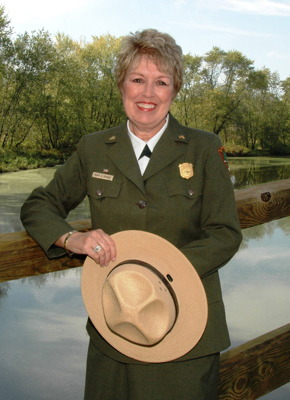 Ms Bomar was a handsome blonde woman in her middle years with a friendly, persuasive demeanor. She sported a charming BBC British accent as result of being an immigrant from that country.
Ms Bomar was a handsome blonde woman in her middle years with a friendly, persuasive demeanor. She sported a charming BBC British accent as result of being an immigrant from that country.
Everyone made small talk until the great oak doors swung open and we were ushered into the hearing room. The hearing room resembled an old fashioned court room, panel in oak, with the Great Seal of Something or other up on one wall. There was a chair for the subject of the hearing, She would look up at a high row of lectern like desks where the Senate Committee would sit. Between the Senators and the subject of the inquiry there was a long table where witnesses, if any, would sit. The rest of the room was filled with church-like pews where we spectators would sit.
The senators straggled in by one's and two's; Burns of Montana, Thomas of Wyoming, Domeneci of New Mexico, and so on. They would get here when they got there. They were, after all, senators. They had done this before and they would do it again. Eventually, most people who were supposed to be here, were here and the chairman of the Senate Committee on Energy and Natural Resources, The Honorable Peter Domenici, called the Committee to order on the subject of Ms Mary Bomar, who had been nominated for the position of Director of the National Park Service.
Now if all this sounds daunting and challenging, it really isn't. Ms Bomar had an excellent record and definitely was among friends. Two of these friends were appearing as witnesses for Mary. They were no other than the entire Pennsylvania Senatorial delegation, Senators Arlen Specter and Senator Richard "Rick" Santorum, both Republicans. Although Specter is by far, the more liberal of the two, he has a hot temper and it is deadly important not to get on the wrong side of "Snarlin' Arlen".
However, the two Pennsylvanians had come not to bury Mary but to praise her fulsomely for her work as regional Director of the Northeast Region (Headquarters in Philadelphia). Senator Santorum noted that she was a "great peacemaker" among the many factions who were trying to decide who was to do what to whom at Independence Hall.
"Snarlin' Arlen" was charmed by Mary and gallantly remarked that "Hollywood Central Casting could not have come up with a better candidate for Director, complete with Delightful accent".
Witness testimony over, the Senators proceeded to question Mary.
Generally, they were vague, rhetorical questions that tended to beget vague, rhetorical answers.
Remember, Mary was largely among friends here. Had she entered the hearing room wearing sandals and flowers in her hair, strumming a guitar and singing protests about pollution and corporate greed, the Senators might have been a bit more critical.
As it was, Mary was questioned a bit closely by Senator Thomas of Wyoming on her position on the eternal joys of snowmobiling in Yellowstone National Park and the necessity of keeping on the good side of those wonderful people in the gateway communities of our national parks.
Senator Thomas also wondered what Mary planned to do about the battalion sized wolf packs that Mary and her ilk had inflicted on the Rocky Mountain West, and were menacing, if not Little Red Riding Hood, then at least the Wyoming Stock Growers Association. He also wondered what Mary planned to do about the NPS Elk and Bison that were threatening to infect his constituents cattle with Brucelosis. Mary planned to meet each problem with "The best science available."
On the other hand, Senator Salazar (D-Co) wanted to know if Mary had any nasty plans to rewrite NPS Management plans along lines suggested by the Greedhead wing of the Republican Party. Mary promised that she would do no such thing.
Senator Cantwell (D-Wa) opened a potential Pandora's box of bureaucratic turf wars when she wondered outloud about the feasibility of moving Mount Saint Helens National Volcanic Monument from the U.S. Forest Service to the National Park Service. What did Mary think of that idea? Mary believed that that idea required some study.
Mary didn't say so, but it would raise an interesting precedent for the transfer of all National Monuments from the Forest Service and the Bureau of Land Management to the Park Service.
Now neighbors, as the feelings these three agencies have toward each other is roughly analogous to that of the Sunnis, the Shiites and the Kurds, that isn't about to happen anytime soon.
Senators Salazar and Alexander (D-Tn) were against air pollution in the National Parks. As it turned out, so was Mary and the subject certainly needed some study, pointing out that answers and solutions could come only through research and, above all, the input and wise council of the person who had asked the question.
Committee Chairman Domenici, an old pro, archly complimented Mary: Slightly raising his eyebrows, he said "Congratulations Ms Bomar! You have gotten almost completely through this hearing without answering any of the questions!"
The hearing was not quite over; it was time for the Villain to arrive.
That would be the liberal Democrat, Ron Wyden of Oregon. It was rumored he would be hostile and he arrived ominously late; Tall, (Put himself through university on a basketball scholarship.) cool, saturnine, and unsmiling. He took his seat and glowered Torquemada-like, down on Mary.
Senator Wyden got right to the point without preliminaries.
"Ms Bomar, are you a crook"?
Mary was understandably a bit incredulous at this line of questioning.
Senator Wyden restated his question.
"Are you a crook"?
Indignantly, Mary shot back that she was not a crook.
Senator Wyden patiently explained the reasons for his suspicions.
It seems that a Mr. Devaney, who was Inspector General for the Department of Interior, had recently announced that if the legendary Diogenes was looking for an honest man or woman, then the upper echelons of the Department of Interior was not the place to start.
 Interior, was according to Mr. Devaney, one of the most corrupt Federal Departments.
Interior, was according to Mr. Devaney, one of the most corrupt Federal Departments.
"And, Ms Bomar, is it not true that you are in the upper echelons of the Department of Interior?" Senator Wyden implied oleaginously. (Ah! Guilt by association! Shades of Senator Joe McCarthy!)
Mary Bomar maintained exactly the right degree of anger and indignation without blowing her cool at this line of questioning.
She reinterated that she was an honest woman.
"If that is indeed the case, then can I have your promise that I will not see your name in any future lists of indictments of Interior officials?" Senator asked silkily.
Mary hotly promised Senator Wyden that he would not see her led off in chains.
And that was pretty much that.
The avuncular Senator Domenici brought the hearing to a close and said that the testimony obtained would be put before the full Senate for a vote on the confirmation on Ms Bomar. Although he did not say so, he doubted if it would be a cliff hanger.
So Mary Bomar was eventually selected to complete the two year term vacated by the resignation of Fran Mainella as Director of George Bush's National Park Service
Why did Fran resign? "To spend more time with her family"? Noooo, not quite.
Why did Senator Ron Wyden savage Mary Bomar; demanding to know "If she was a crook"?
Well neighbors, it all had to do with the nature loving owner of the Washington Redskins football team, Dan Snyder.Mr. Snyder had a problem that he thought Fran Mainella, Director of the NPS, could rectify. It seems that trees on the Park Services C & O canal were blocking Dan's view of the Potomac.
Technically, the trees were his to dispose of as his wont; HOWEVER, like many a property owner on the C & O canal, Mr. Snyder had signed a Scenic Easement agreement stating that he/she would not cut down trees on their property. This is a cheap way of maintaining a view or preserving the ecology.
The trees had grown as trees will do, and were blocking the view. Could not a little minor exception be made, asked Mr. Snyder (Ah! the slippery slope to bureaucratic perdition!) It is said that seats were offered to join Mr. Snyder as his guests at Redskin games.
At any rate, Mr. Snyder's tree crew showed up to "do a little thinning".
Sometime later the Chief Ranger of the C & O Canal, Robert M. Danno showed up and hotly noticed the clear cut and was told by higher ups that "everything was OK" and "not to notice".
Danno continued to notice. The story got into THE WASHINGTON POST. Montgomery County, which has stricter environmental regs than the NP's, went on the warpath; there was hell to pay. Danno continued to notice. The NPS decided they would fix his wagon with a bogus charge of theft of artifacts. The Bush administration decided that Fran might be happier elsewhere and so she resigned. Danno was cleared on all charges.
The whole alarming story is told in Danno's autobiography "WORTH FIGHTING FOR: A park rangers unexpected battle against federal bureaucrats and the Washington Redskins owner Dan Snyder".
Definitely worth reading.